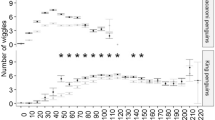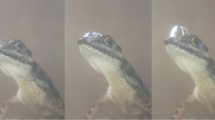Abstract
Knowing the depth zone of neutral buoyancy of divers is important because buoyancy can determine how animals manage their energy budget. In this study, we estimate the depth zone of neutral buoyancy of free-ranging cormorants for the first time, using time-depth recorders. We discovered that vertical ascent rates of 12 Crozet and 15 Kerguelen diving blue-eyed shags (respectively Phalacrocorax melanogenis and P. verrucosus) slowed down considerably at the 50–60 m depth zone. We suggest this was due to birds trying to reach the surface from that point upwards using reduced locomotor activity because the force of buoyancy becomes greater than the force of gravity at that depth. The results show a shift of this depth zone in relation to maximum targeted dive depth, suggesting cormorants may control buoyancy through respiratory air volume adjustment. Interestingly, 60 m is close to the maximum depth zone reached by these two species during dives lasting 4 min, their estimated behavioural aerobic dive limit. This suggests that the decision to swim deeper has a direct consequence on the energy budget, with time spent recovering at the surface (time thus lost to foraging) strongly increasing relative to the preceding time of submergence. Resources found in deeper waters must be of sufficient quantity or quality to justify crossing the frontier of physical neutral buoyancy.




Similar content being viewed by others
References
Alexander RM (1990) Size, speed and buoyancy adaptations in aquatic animals. Am Zool 30:189–196
Biuw M, McConnell B, Bradshaw CJA, Burton H, Fedak M (2003) Blubber and buoyancy: monitoring the body condition of free-ranging seals using simple dive characteristics. J Exp Biol 206:3405–3423
Butler PJ, Jones DR (1997) Physiology of diving of birds and mammals. Physiol Rev 77:837–899
Chastel O, Weimerskirch H, Jouventin P (1995) Body condition and seabird reproductive performance: a study of three petrel species. Ecology 76:2240–2246
Cook TR, Cherel Y, Bost C-A, Tremblay Y (2007) Chick-rearing Crozet shags (Phalacrocorax melanogenis) display sex-specific foraging behaviour. Antarct Sci 19:55–63
Crocker DE, Le Boeuf BJ, Costa DP (1997) Drift diving in female northern elephant seals: implications for food processing. Can J Zool 75:27–39
Eckert R, Randall D, Burggren W, French K (1999) Animal physiology: mechanisms and adaptations. De Boeck, Paris
Elliot KH, Davoren GK, Gaston AJ (2007) The influence of buoyancy and drag on the dive behaviour of an Arctic seabird, the thick-billed murre. Can J Zool 85:352–361
Halsey LG, Butler PJ, Blackburn TM (2006) A phylogenetic analysis of the allometry of diving. Am Nat 167:276–287
Hays GC, Metcalfe JD, Walne AW (2004) The implications of lung regulated buoyancy control for dive depth and duration. Ecology 85:1137–1145
Hochscheid S, Bentivegna F, Speakman JR (2003) The dual function of the lung in chelonian sea turtles: buoyancy control and oxygen storage. J Exp Mar Biol Ecol 297:123–140
Hustler K (1992) Buoyancy and its constraints on the underwater foraging behaviour of reed cormorants Phalacrocorax africanus and darters Anhinga melanogaster. Ibis 134:229–236
Grémillet D, Chauvin C, Wilson RP, Le Maho Y, Wanless S (2005) Unusual feather structure allows partial plumage wettability in diving great cormorants Phalacrocorax carbo. J Avian Biol 36:57–63
Ihaka R, Gentleman R (1996) R: a language for data analysis and graphics. J Comput Graph Stat 5:299–314
Kato A, Watanuki Y, Shaughnessy P, Le Maho Y, Naito Y (1999) Intersexual differences in the diving behaviour of foraging subantarctic cormorant (Phalacrocorax albiventer) and Japanese cormorant (P. filamentosus). C R Acad Sci Paris 322:557–562
Kato A, Watanuki Y, Nishumi I, Kuroki M, Shaugnessy P, Naito Y (2000) Variation in foraging and parental behavior of King cormorants. Auk 117: 718–730
Kato A, Ropert-Coudert Y, Grémillet D, Cannell B (2006) Locomotion and foraging strategy in foot-propelled and wing-propelled shallow-diving seabirds. Mar Ecol Prog Ser 308:293–301
Kooyman GL (2004) Genesis and evolution of bio-logging devices: 1963–2002. Mem Natl Inst Polar Res 58:15–22
Kooyman GL, Hammond DD, Schroeder JP (1970) Bronchograms and tracheograms of seals under pressure. Science 169:82–84
Lovvorn JR, Croll DA, Liggins GA (1999) Mechanical versus physiological determinants of swimming speeds in diving Brünich’s guillemots. J Exp Biol 202:1741–1752
Lovvorn JR, Watanuki Y, Kato A, Naito Y, Liggins GA (2004) Stroke patterns and regulation of swim speed and energy cost in free-ranging Brünnich’s guillemots. J Exp Biol 207:4679–4695
Meister W (2005) Histological structure of the long bones of penguins. Anat Rec 143:377–387
Miller PJO, Johnson MP, Tyack PL, Terray EA (2004) Swimming gaits, passive drag and buoyancy of diving sperm whales Physeter macrocephalus. J Exp Biol 207:1953–1967
Minamikawa S, Naito Y, Sato K, Matsuzawa, Bando T, Sakamoto W (2000) Maintenance of neutral buoyancy by depth selection in the loggerhead turtle Caretta caretta. J Exp Biol 203:2967–2975
Orta J (1992) Family Phalacrocoracidae (Cormorants). In: Del Hoyo J, et al (ed) Handbook of the birds of the world, vol 1. Lynx Edicions, Barcelona, pp 326–353
Quintana F, Wilson RP, Yoria P (2007) Dive depth and plumage air in wettable birds: the extraordinary case of the imperial cormorant. Mar Ecol Prog Ser 334:299–310
Ropert-Coudert Y, Grémillet D, Kato A (2005) Diving angles of great cormorants. Polar Biosci 18:54–59
Ropert-Coudert Y, Grémillet D, Kato A (2006) Swim speeds of free-ranging great cormorants. Mar Biol 149:415–422
Ribak G, Weihs D, Arad Z (2005) Submerged swimming of the great cormorant Phalacrocorax carbo sinensis is a variant of the burst-and-glide gait. J Exp Biol 208:3835–3849
Sato K, Naito Y, Kato A, Niizuma Y, Watanuki Y, Charrassin JB, Bost C-A, Handrich Y, Le Maho Y (2002) Buoyancy and maximal diving depth in penguins: do they control inhaling air volume? J Exp Biol 205:1189–1197
Schmid D, Grémillet DJH, Culik BM (1995) Energetics of underwater swimming in the great cormorant (Phalacorcorax carbo sinensis). Mar Biol 123:875–881
Schmidt-Nielsen K (1983) Animal physiology. Cambridge University Press, Cambridge
Schreer JF, Kovacs KM (1997) Allometry of diving capacity in air-breathing vertebrates. Can J Zool 75:339–358
Skrovan RC, Williams TM, Berry PS, Moore PW, Davis RW (1999) The diving physiology of bottlenose dolphins (Tursiops truncatus) II. Biomechanics and changes in buoyancy at depth. J Exp Biol 202:2749–2761
Tremblay Y, Cook TR, Cherel Y (2005) Time budget and diving behaviour of chick-rearing Crozet shags. Can J Zool 83:971–982
Watanuki Y, Niizuma Y, Gabrielsen GW, Sato K, Naito Y (2003) Stroke and glide of wing-propelled divers: deep diving seabirds adjust surge frequency to buoyancy change with depth. Proc R Soc Lond B 270:483–488
Watanuki Y, Takahashi A, Daunt F, Wanless S, Harris M, Sato K, Naito Y (2005) Regulation of stroke and glide in a foot-propelled avian diver. J Exp Biol 208:2207–2216
Webb PM, Crocker DE, Blackwell SB, Costa DP, Le Boeuf BJ (1998) Effects of buoyancy on the diving behaviour of northern elephant seals. J Exp Biol 201:2349–2358
Williams TM, Davis RW, Fuiman LA, Francis J, Le Boeuf BJ, Horning M, Calambokidis J, Croll DA (2000) Sink or swim: strategies for cost-efficient diving by marine mammals. Science 288:133–136
Wilson RP (2006) Fishing made easy: tips and tricks on decisions for optimal foraging in Magellanic penguins, Spheniscus magellanicus. Acta Zool Sin 52(Suppl):514–523
Wilson RP, Zimmer I (2004) Inspiration by Magellanic Penguins: reduced swimming effort when under pressure. Mar Ecol Prog Ser 278:303–307
Wilson RP, Hustler K, Ryan PG, Burger AE, Nöldeke EC (1992) Diving birds in cold water: do Archimedes and Boyle determine energetic costs? Am Nat 140:179–200
Wilson RP, White CR, Quintana F, Halsey LG, Liebsch N, Martin GR, Butler PJ (2006) Moving towards acceleration for estimates of activity-specific metabolic rate in free-living animals: the case of the cormorant. J Anim Ecol 75:1081–1090
Acknowledgments
We wish to thank Yoshihisa Mori for a most interesting discussion on optimal output strategy in diving animals and Pierre Legagneux for a debate on the use of statistics in ecology. Thank’s also to François Brischoux for most valuable critiques of an earlier version of the manuscript, and to anonymous reviewers for their constructive recommendations during the revision process. Special thanks go to Jon Cook for his advice on English usage. Animals in this study were cared for in accordance with the guidelines of the ethics committee of the French Polar Institute (Institut Paul Emile Victor – IPEV). This work was supported financially and logistically by the IPEV (Program 109 and 394) and the Terres Australes et Antarctiques Françaises (TAAF).
Author information
Authors and Affiliations
Corresponding author
Additional information
Communicated by M.I. Taylor.
Rights and permissions
About this article
Cite this article
Cook, T.R., Bailleul, F., Lescroël, A. et al. Crossing the frontier: vertical transit rates of deep diving cormorants reveal depth zone of neutral buoyancy. Mar Biol 154, 383–391 (2008). https://doi.org/10.1007/s00227-008-0939-6
Received:
Accepted:
Published:
Issue Date:
DOI: https://doi.org/10.1007/s00227-008-0939-6




